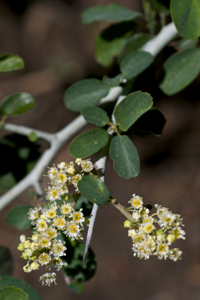The seeds of Ceanothus cordulatus can self-disperse by forcibly ejecting from the seed pods when they ripen. The seeds are highly dependent on fire for germination. Leaves and the soil around this species are high in nitrogen due to the presence of Frankia , a nitrogen-fixing bacteria that associates with its roots.
Photo Credit: © Eric in SF via Wikimedia Commons
Ceanothus cordulatus
Common Name: whitethorn ceanothus
Plant Functional Group: Evergreen broadleaf
Class > Order > Family: Magnoliopsida > Rosales > Rhamnaceae
What does the species look like?
This evergreen shrub grows up to 1.5 meters tall and is spiny at the tips of the branches. Older bark is greyish-white, and younger twigs are yellow-green. The oval leaves are up to 3 centimeters long, have three ribs, and are sometimes hairy. The small white flowers have 5 petals and are found in clusters at the end of branches. The rough ridged fruit is 0.5 centimeters long and has three valves, each containing one seed.Ceanothus cordulatus is found on rocky ridges and in open pine forests at elevations between 900 and 2900 meters.
Where is the species found?
States & Provinces
CA, NV, OR
Which phenophases should I observe?
Do you see...?
Leaves
Young leaves How many young leaves are present?
Less than 3 3 to 10 11 to 100 101 to 1,000 1,001 to 10,000 More than 10,000
Flowers
Flowers or flower buds More...
How many flowers and flower buds are present? For species in which individual flowers are clustered in flower heads, spikes or catkins (inflorescences), simply estimate the number of flower heads, spikes or catkins and not the number of individual flowers.
Less than 3 3 to 10 11 to 100 101 to 1,000 1,001 to 10,000 More than 10,000
Open flowers More...
What percentage of all fresh flowers (buds plus unopened plus open) on the plant are open? For species in which individual flowers are clustered in flower heads, spikes or catkins (inflorescences), estimate the percentage of all individual flowers that are open.
Less than 5% 5-24% 25-49% 50-74% 75-94% 95% or more
Fruits
Fruits Ceanothus cordulatus , the fruit is a three-lobed capsule that changes from green to reddish-green to dark brown, becomes slightly sticky, and splits open to expose the seeds. Do not include empty capsules that have already dropped all of their seeds.More...
How many fruits are present?
Less than 3 3 to 10 11 to 100 101 to 1,000 1,001 to 10,000 More than 10,000
Ripe fruits Ceanothus cordulatus , a fruit is considered ripe when it has turned dark brown and has split open to expose the seeds. Do not include empty capsules that have already dropped all of their seeds.More...
What percentage of all fruits (unripe plus ripe) on the plant are ripe?
Less than 5% 5-24% 25-49% 50-74% 75-94% 95% or more
Recent fruit or seed drop More...
How many mature fruits have dropped seeds or have completely dropped or been removed from the plant since your last visit?
Less than 3 3 to 10 11 to 100 101 to 1,000 1,001 to 10,000 More than 10,000
What do these phenophases look like?
There is currently no photoguide available for this species. If you'd like help us create one, use the guidance document and species template provided here . Then send it via email to education@usanpn.org when it is complete.
